"Gucci is a feeling" read the tagline of the house's autumn/winter '81 campaign, and a new immersive exhibition in London certainly ensures that every visitor feels it. Here, we walk through seven of the unmissable moments within the walls of the unmissable Gucci Cosmos, coloured by insights from one of the creative forces behind it
"The show is very different here," says British contemporary artist Es Devlin, who co-envisioned and designed the immersive new Gucci Cosmos exhibition at London's 180 The Strand venue. "It’s quite expanded from Shanghai," she adds, referring to the first iteration of the showcase which debuted in China earlier in the year.
It's a meaningful second stop for the travelling archival exhibit, with Gucci's roots in London running deeper than many realise. In fact, the brand's story began during the turn of the 19th century in the British capital, with a young Guccio Gucci hired to man the newly installed electric lift at The Savoy Hotel. For the seven minutes it would take the contraption to reach the top floor – with smelling salts and brandy on hand to ease uncomfortable and claustrophobic guests – Gucci no doubt observed and soaked up the habits, style and, most importantly, the luggage of the elite. He returned to Florence in 1921, began his eponymous leather-goods house, and the rest is fashion history.
Instead of visitors learning the Gucci story in their minds when they read the words, I want to come from the gut. I want them to feel it in their gut when they experience the sense of colour, music, emotion.
Es Devlin, the Gucci Cosmos conceptualiser and designer
Celebrating all 102 years of this history, Gucci Cosmos is a playful and immersive voyage that spirals backwards and forwards through the decades, forming both a love letter to the house's Florentine roots and a paean to its enduring creativity. "We haven’t really adopted chronology as an organising principle in the exhibition at all," says Devlin, who worked closely alongside curator Maria Luisa Frisa and creative director Sabato De Sarno to bring the archive to life, and in Devlin's own words, "make the objects the protagonists" "Instead of visitors learning the Gucci story in their minds when they read the words, I want to come from the gut. I want them to feel it in their gut when they experience the sense of colour, music, emotion."
An ascending initiation
To access the main exhibition spaces, visitors enter a large-scale reproduction of The Savoy's famous lacquered lift, the first electric elevator in London. Unveiled in 1889, it was affectionately referred to as the 'Ascending Room' by its astonished visitors, who weren't used to standing so close together in an enclosed windowless box. "They freaked out, a lot of them. They either chatted a lot or they were dizzy and ill, needing smelling salts and brandy," Devlin says. The invention – remarkable for the time – would have been constantly used by Guccio as he escorted guests and their luggage in the lift, allowing him study the ways of the international elite, and most importantly, their luggage.
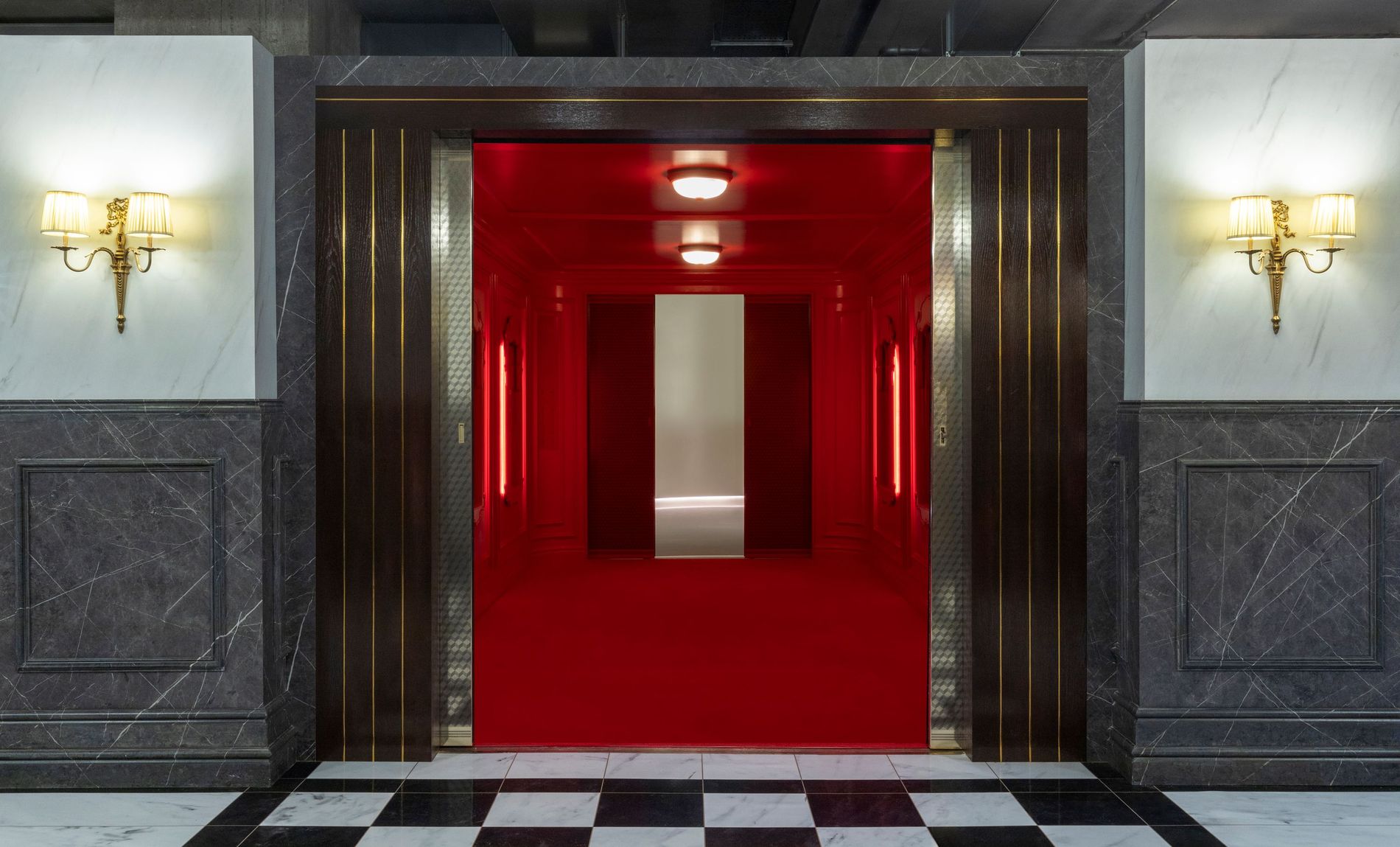
Visitors access the exhibition via an all-red lift, modelled on the elevator at The Savoy Hotel that Guccio Gucci worked at in the late 19th century. Photo: Courtesy of Gucci
The Gucci Cosmos recreation, lacquered in all-out red just like the original, whisks small groups of visitors on an ascending son-et-lumière journey, telling the story of how those seven-minute journeys would one day inspire the founding of an artisanal luggage atelier.
Step inside the zoetrope
Gucci has long drawn inspiration from the equestrian world, a connection celebrated in Gucci Cosmos's 'Zoetrope' installation. Punctuated with immersive large-format screens presenting evocative video footage of a galloping horse, accompanied by a soundscape of equine rhythm, the displayed archival pieces demonstrate how different equestrian icons have fired the imagination over time. This specific exhibit includes the Horsebit, with its double ring and bar – which became a distinctive element in 1953 when Ado Gucci introduced it on the iconic loafer – and the signature green-red-green Web stripe, inspired by the strap that holds a horse's saddle in place.
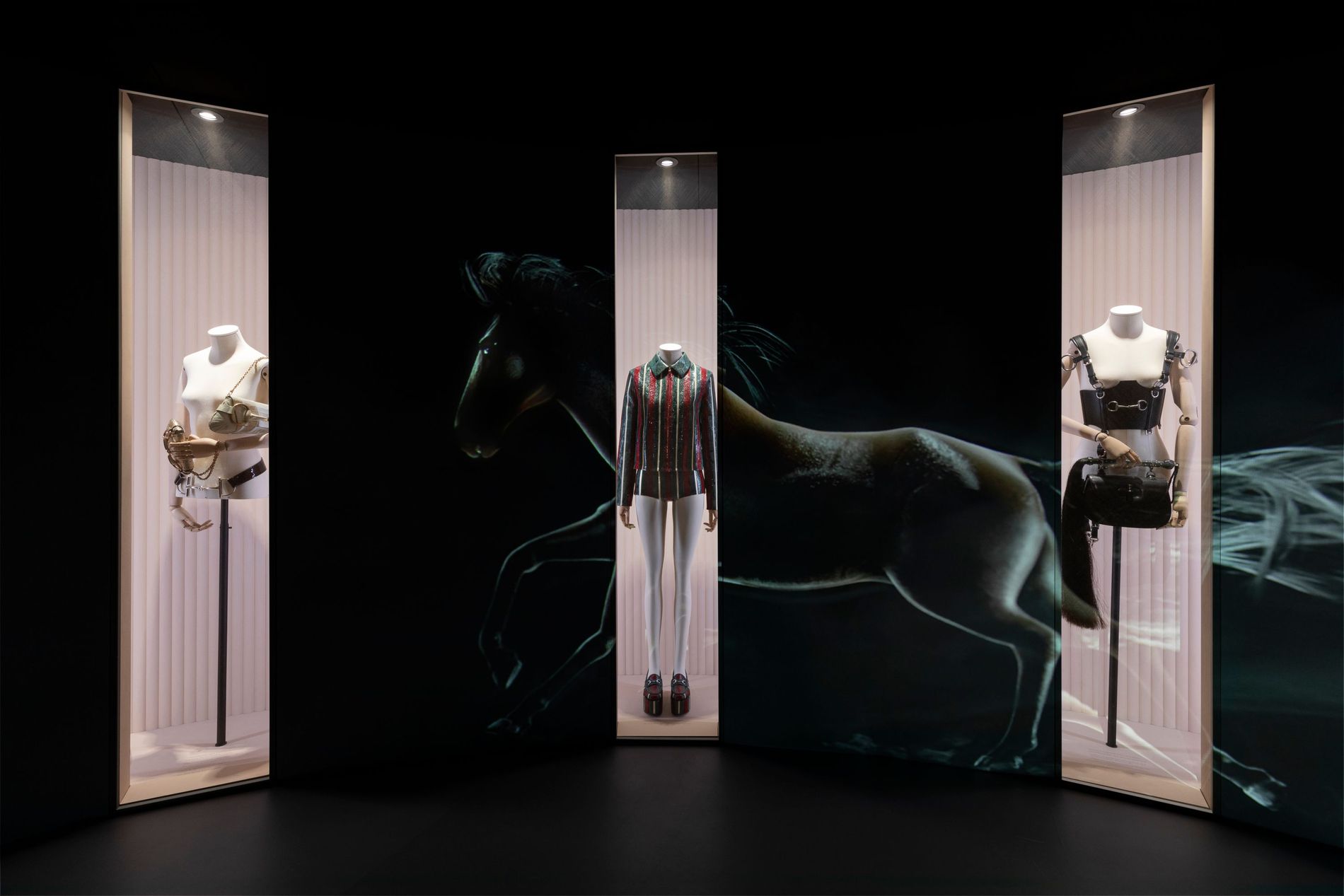
The 'Zoetrope' space plays with immersive video, light and sound to explore Gucci's equestrian spirit. Photo: Courtesy of Gucci
'Zoetrope' is also a nod to the ways in which Gucci's creative directors have playfully subverted equestrianism's traditional aristocratic practices, with examples including a Tom Ford-designed riding crop and Horsebit black leather corset by Alessandro Michele.
Drawers of archival treasures
To enter the 'Archivio' space is to explore the origins of Gucci's most iconic bags. Housed in a breathtaking, maze-like turqoise room, lined with mirrors that create a sense of infinity, the installation is reminiscent of the Gucci Archive in Florence, lined with a multitude of cabinets and drawers for visitors to explore themselves. "I wanted to not just show you a scarf, for example, but I wanted to conjure up how I felt when I opened the drawer of the archive and discovered the scarf," explains Devlin.
The historic bags on display include those now considered classics: the Bamboo 1947, the Jackie 1961, and Hrosebit 1955, the Gucci Diana and the Dionysus. The versions within 'Archivio' encompass a rare and colourful 1960s hemp interpretation of the Guccio Gucci-designed Bamboo bag, alongside a revisited leather version from the 1990s; an early example of the Jackie bag, featuring its signature piston clasp and Web stripe, as well as a late-1970s update featuring the legendary GG pattern.
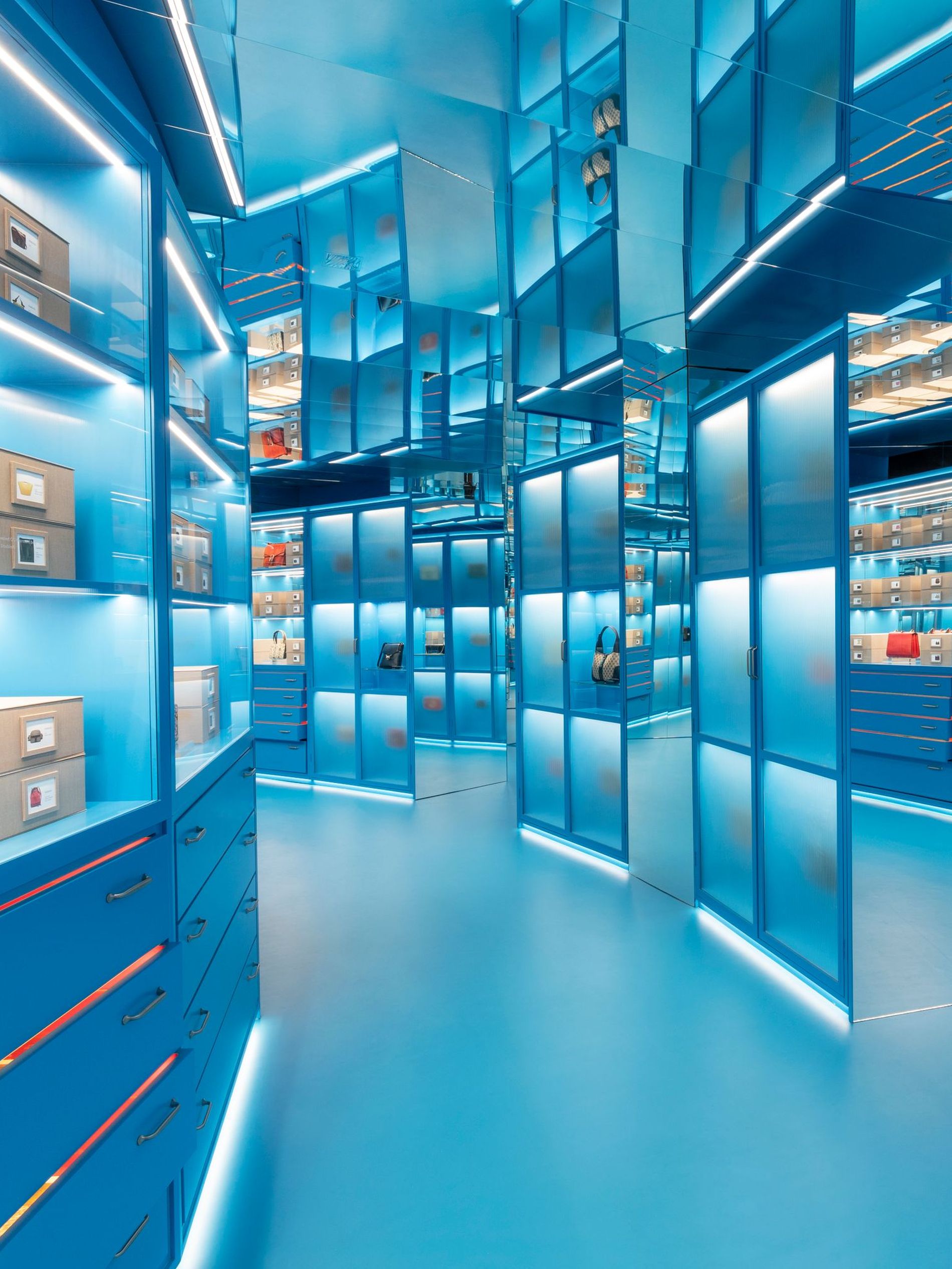
Es Devlin, who designed and conceptualised the exhibition, wanted the 'Archivio' space to give visitors the same experience that she had at Gucci's archive in Florence, complete with cabinets and drawers to explore. Photo: Courtesy of Gucci
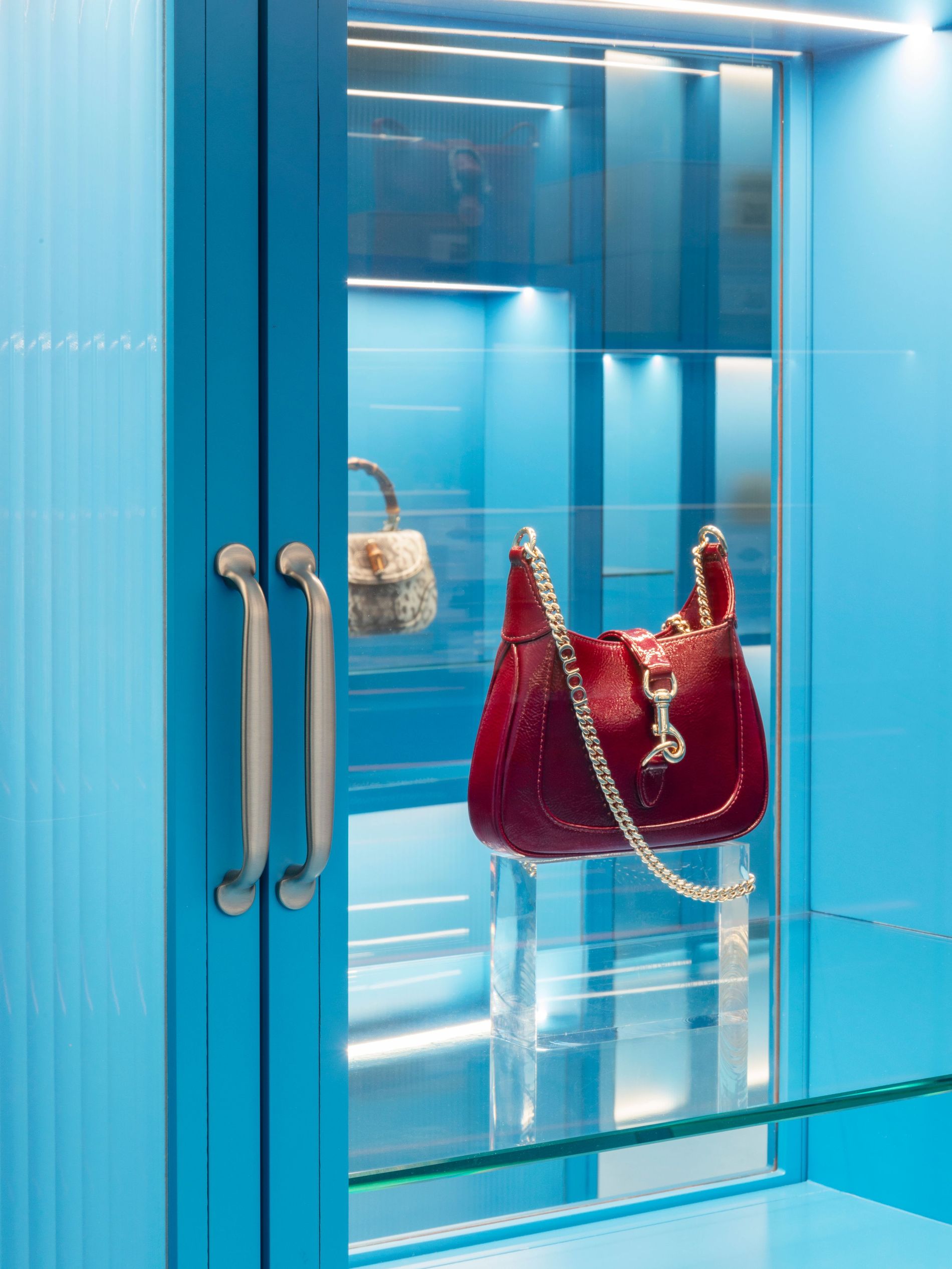
Photo: Courtesy of Gucci
Rounding out the selection are handbags by De Sarno for spring/summer '24 including a Jackie Notte, a bucket bag with snap-hook closure and Web strap, and a patent leather Bamboo 1947 – all in the new signature 'Rosso Ancora' shade of red. Alongside the cabinets, visitors can continue their archive dive by exploring drawers containing reproductions of illustrations by Vittoria Accornero de Testa, artisans' sketchbooks and technical drawings, as well as vintage advertising campaigns.
Giants in repose
Stepping into 'Two', visitors find a stunning space in which a pair of monumental 10-metre-tall white statues hover just above the floor. Lying on their sides, like guards at a long-lost ancient temple, the statues' become a blank canvas for a mesmerising loop of projections of images of men's and women's suits from Gucci's past and present. nodding to the house's trailblazing belief in unisex fashion. "In Shanghai, these two enormous androgynous sculptures were towering above us," Devlin explains. Here, our whole perspective is shifted so we feel like we're lying down on the floor looking up at them."
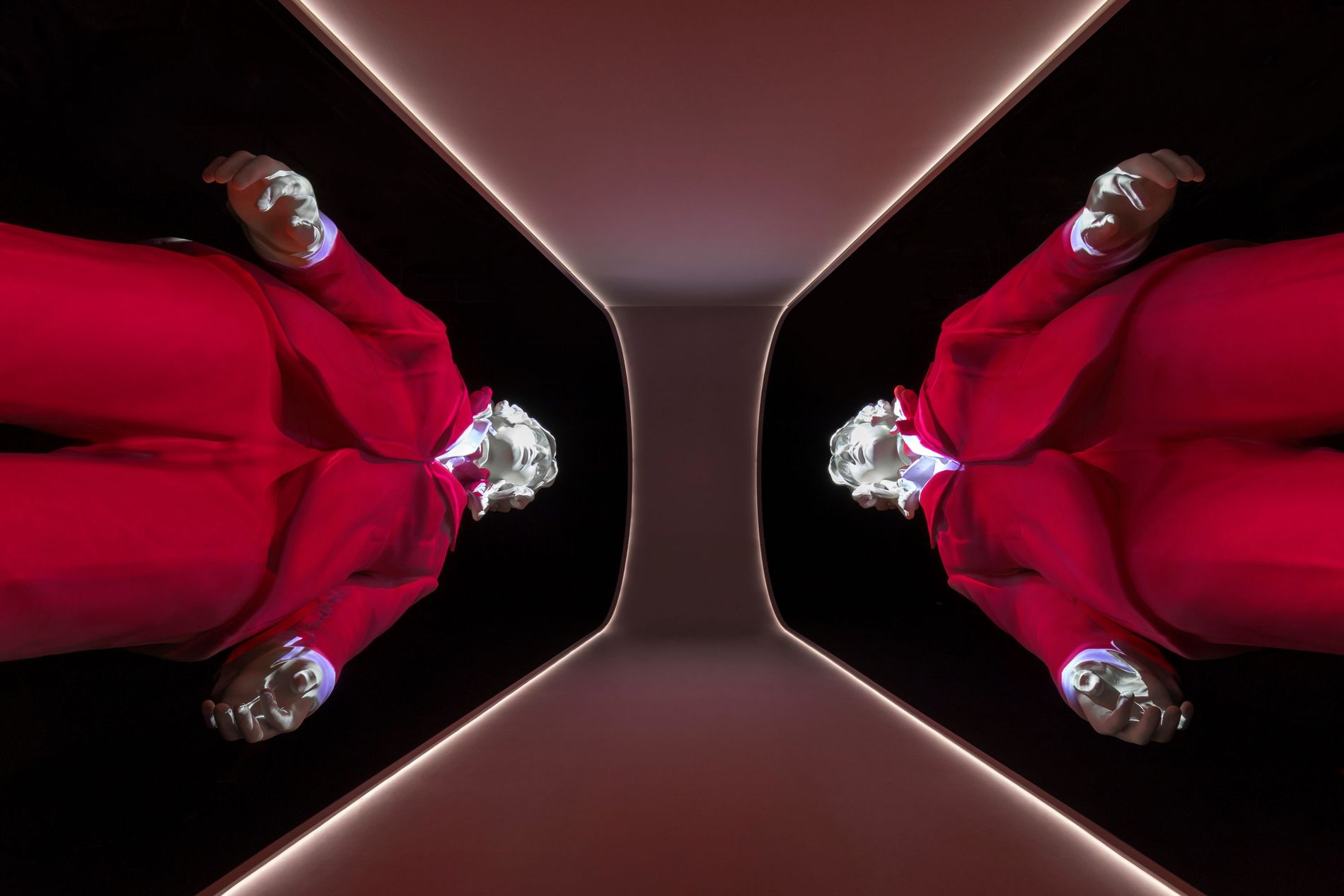
The mammoth sculptures represent ideas of androgony and identity that are inherent to the house. Photo: Courtesy of Gucci
Accompanying the constant evolution of clothing on the statues, the rest of the room is projected with skyscapes suggesting the infinite, while the soundtrack features a poem written and recited by Devlin – exploring the concept of our bodies as multitudes.
The garden of Eden
The 'Eden' space of Gucci cosmos brings to life the tale of Flora, an exquisite and delicately naturalistic image of plants and fauna from 1966. Commissioned by Rodolfo Gucci from acclaimed Italian artist and illustrator Vittorio Accornero de Testa for a silk scarf created for Princess Grace of Monaco, it became the leitmotif for Gucci's 1981 ready-to-wear collection.
I love the fact that people want to write themselves into the narrative. I think it's beautiful.
Es Devlin, the Gucci Cosmos conceptualiser and designer
The room is lined with mirrors, which not only creates a sense of infinity, but also invites the visitor to insert themselves in the world with a selfie. "I think the word selfie is unhelpful because I think it devalues the act of self portraiture," Devlin comments. "Why don't we celebrate it? I love the fact that people want to write themselves into the narrative. I think it's beautiful."
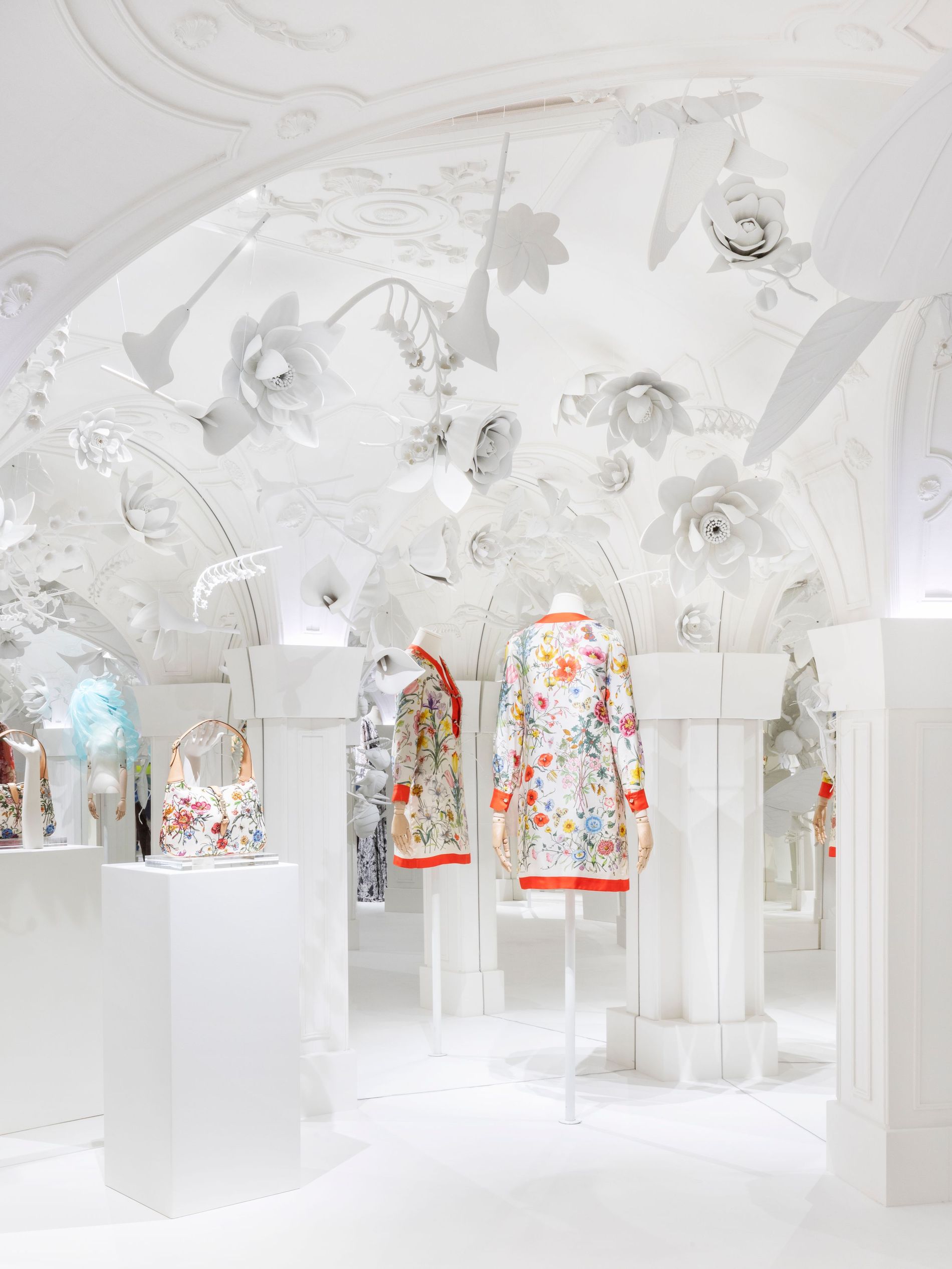
With flowers and insects suspended above, the 'Eden' room is a stunning celebration of Gucci's influential 'Flora' universe. Photo: Courtesy of Gucci
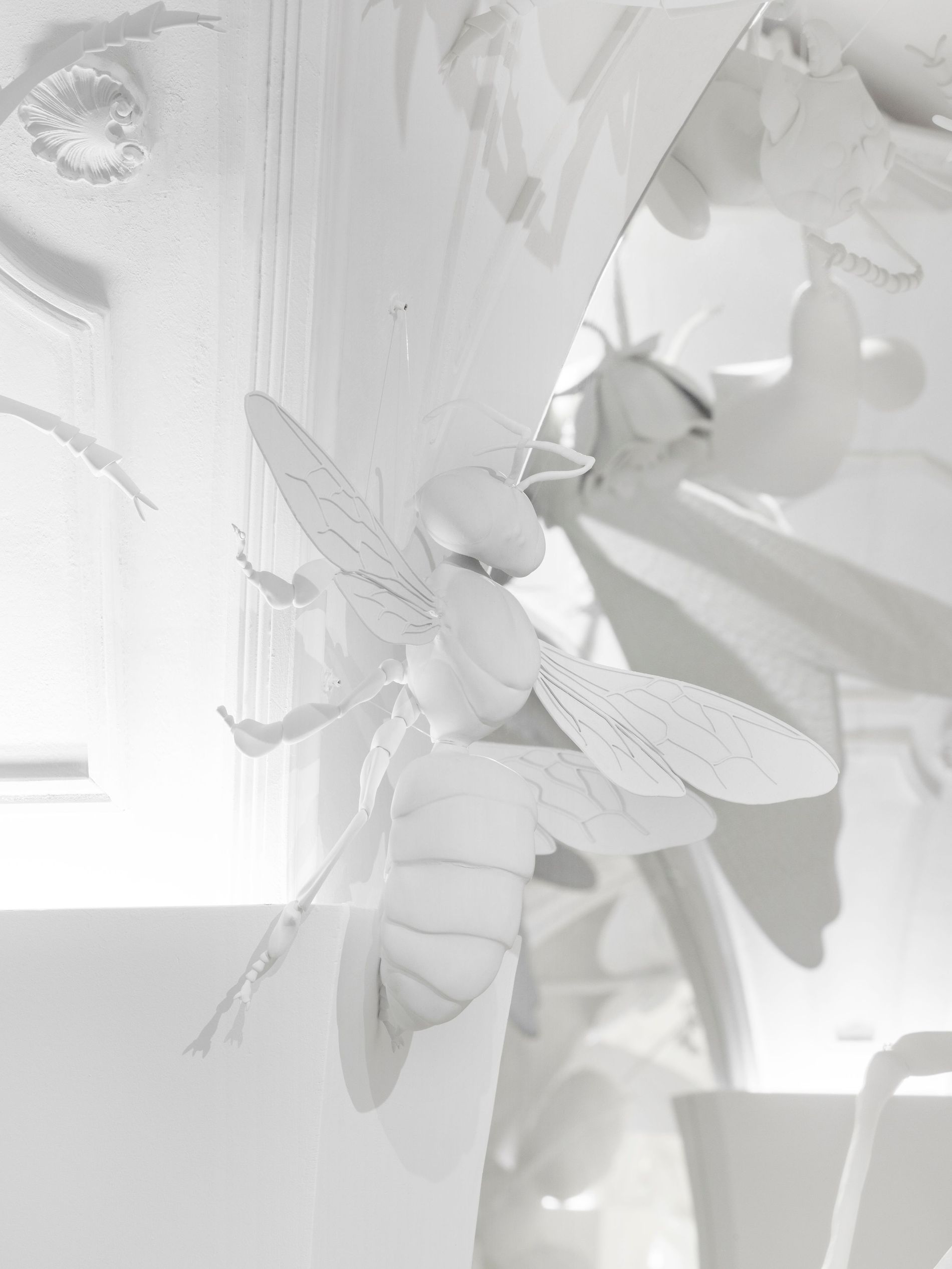
Photo: Courtesy of Gucci
Conjuring the feeling of being inside the vaults of a Florentine palazzo, Gucci's ongoing relationship to the diversity and beauty of the biosphere is symbolised in an installation of larger-than-life white sculptures of the flowers and insects featured in Accornero's designs. The sculptures are suspended above key archive pieces that reveal 'Flora''s constant ability to inspire.
A morphing cabinet of wonders
Here, a rotating cabinet of curiosities spins, revealing and concealing a wildly eclectic collection of garments, accessories and curios. The drawers and compartments of the three-metre high structure mechanically slide in and out, showcasing the full breadth of the house's design range. Through the slow and hypnotic movement, visitors can observe everything from a Ford 2001 collection look with a black leather bustier to a 2006 Frida Giannini golden evening gown and GG velvet bag with metal and rhinestone handle, as well as a punk-inspired spherical leather bag with metal spikes from 2019 by Michele. Newer pieces are included too, such as the crystal-embellished Jackie Notte bag by De Sarno as first spotted on the recent spring/summer '24 runway.

At the heart of the exhibition is a rotating cabinet of curiosities that spins, revealing and concealing a wildly eclectic collection of garments, accessories and curios. Photo: Courtesy of Gucci
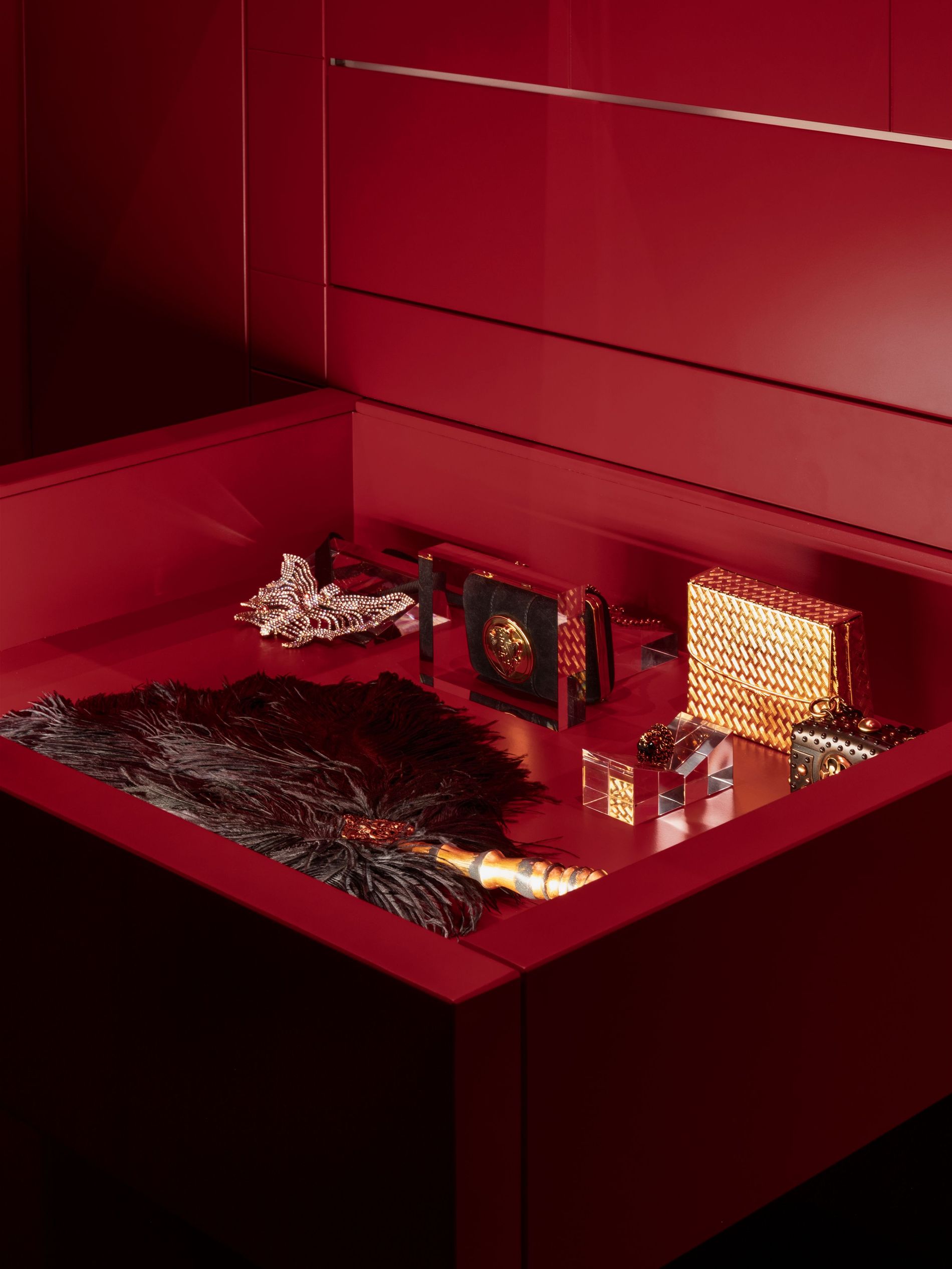
Photo: Courtesy of Gucci
Also present is a selection of singular jewellery spanning over six decades, all the way through to De Sarno's recently unveiled Marina Chain collection inspired by iconic archival styles from the late '60s, complemented by animal-shaped metal objects from the early '70s in homage to the English countryside, not to mention a Ford era electric guitar.
Sabato De Sarno's world of Ancora
With 'Ancora', visitors enter a room directly inspired by De Sarno's debut collection and runway show for the house . Decorated entirely in the new signature Rosso Ancora shade of red, the room is centred by a semi-transparent parallelepiped structure containing screens within a mirror-clad inner chamber. Projected onto the semi-transparent walls is a series of personal memories, phrases and other fragments in both Italian and English – the words appearing and disappearing in mesmerising motion.
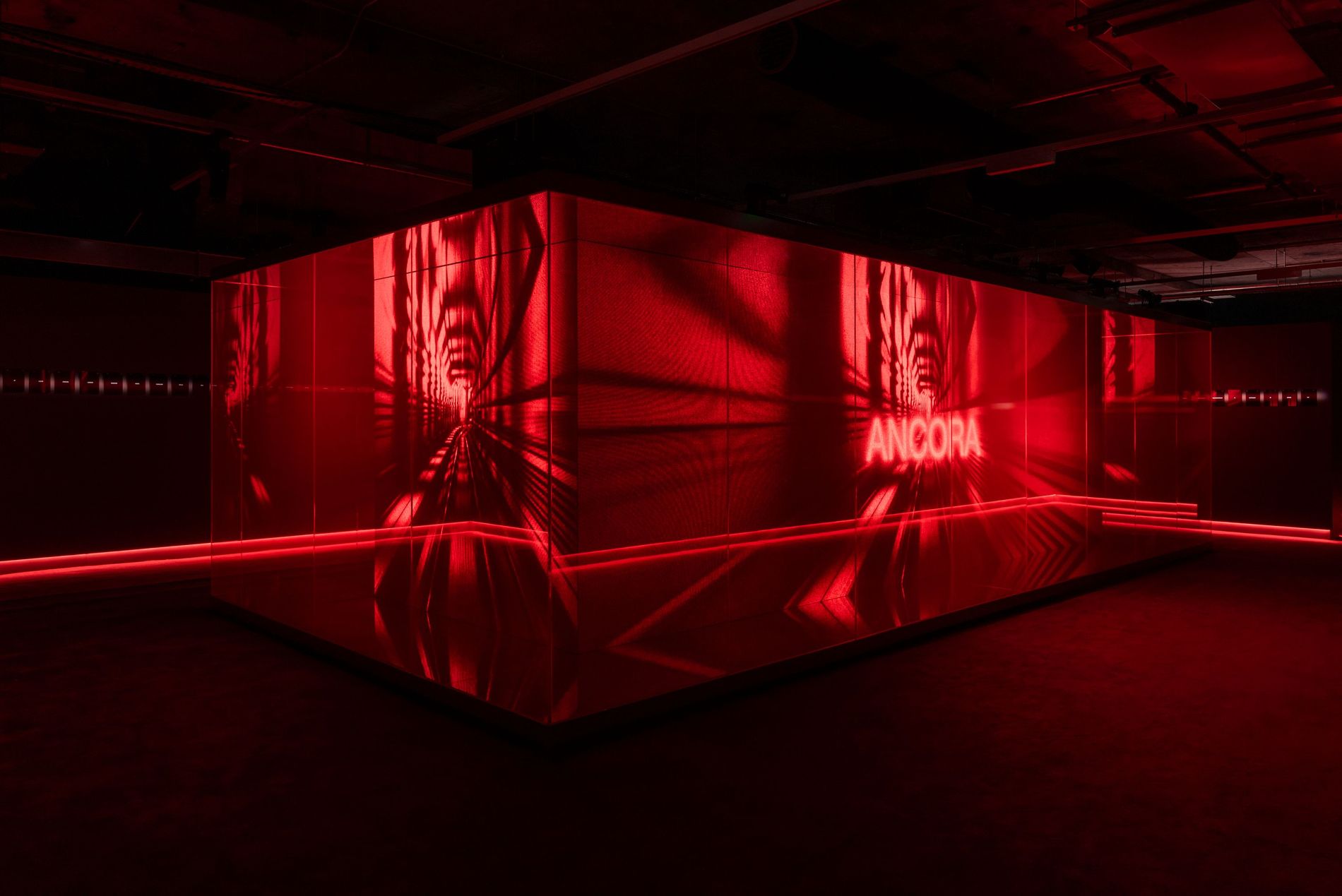
The final 'Ancora' installation plunges visitors into De Sarno's 'Rosso Ancora' hue, to deliver an immersive and poetic message. Photo: Courtesy of Gucci
Merging installation art with the essence of poetry, the perimeter walls of the 'Ancora' space are lined with cards – each emblazoned with a single word – that visitors can move around to create their own compositions.
Gucci Cosmos is open now at 180 Studios, 180 The Strand in London, running until 31 December 2023.